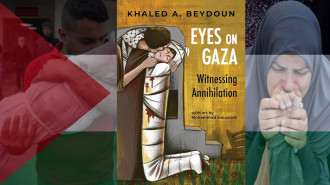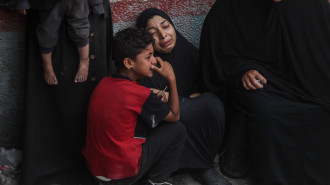
How the climate crisis is putting Morocco's cultural traditions at risk

As he embarks on his professional life, 24-year-old Mohammed isn’t merely facing the whims of the desert.
With the increasingly unpredictable weather, the rising temperatures and the years-long drought, his surroundings and cultural marks have been rapidly changing.
Across the country, and even more so in Southern Morocco, the water supply has been shrinking, leading to a considerable decline in grazing areas.
This has affected the revenues of local tribes, which are largely stemming from the breeding and selling of their animal herds.
Despite these hurdles, Mohammed, a recent graduate, wholeheartedly vowed to devote his adult life to reviving his family’s craft, camel husbandry.
Their experience could have deterred him. After all, only a few years ago, his grandfather was forced to sell his cattle and settle in the city. Rather, he says this has reinforced his will to keep his ancestors' traditions alive.
“As a family, circumstances have forced us to give up raising livestock in the desert. This abandonment was not just a relinquishment of financial returns and a source of livelihood; it went beyond that to become a change in our habits and culture,” Mohammed tells The New Arab.
“Pastoralism among desert dwellers is more than just a livelihood; it's a way of life and a cultural heritage that is part of our identity, resisting to survive,” he adds.
“[Our] social structure includes a form of spontaneous solidarity and cohesion, where communities, for example, undertake the costs of feeding and transporting livestock without compensation in case their owners are unable to do so.”
But Mohammed is facing a dilemma unknown to his elders.
After studying for two years in the southern city of Agadir, he has encountered a harsher climate and consequently, a more competitive and tighter job market.
Due to the production deficit and crisis suffered by camel breeders, work opportunities have become rarer and riskier.
Like him, Morocco’s breeders and farmers are well aware they aren’t dealing with the climate hazards experienced by previous generations.
Morocco has endured many droughts in the past. But the latest, the most intense in over four decades, has entered its sixth year.
Some have seen their harvests destroyed, at times consecutive years, while others have lost part of their land due to desertification.
Many breeders have been forced to sell their animals and in the most desperate situations, had to slaughter some of them.
The nomads, who had long skillfully adapted to known climate challenges, are now clueless in light of the new difficulties they have to brave.
Even though their number had already plummeted before this acute water crisis from 68, 540 people in 2004 to 25,274 in 2014, their existence as a group is at stake.
'Climate change is devastating my region'
In Morocco’s most remote regions, the inhabitants have traditionally adapted to the lack of water and developed traditional irrigation and collective distribution systems.
However, the lands that used to provide enough crops for the local communities have seen their production dramatically reduced.
Overall, the ecosystem skillfully maintained by previous generations has been shattered.
The southeastern region of Zagora, which harbours one of the country’s major oases, has been among those hit the hardest by the recent climate changes.
Formerly known for its exported dates, a vital resource for countless families, the disappearance of its palm groves has forced the inhabitants to rely on imports for their consumption.
In Ksar Bounou, his family’s village, Mohamed Leghtas, an environmental activist and member of the Moroccan Coalition for Climate Justice, asserts only about ten families remain following the decades-long and progressive migration of hundreds of others.
Those who are left are struggling to resist the disruption of the seasons, the rampant desertification and the dizzying siltation, with houses literally disappearing under the sand.
“Climate change is devastating my region,” he laments.
The unprecedented and persisting lack of rain has impacted the whole country, leading to government restrictions, including limitations on the country's traditional public baths and, more importantly, calls for a reshuffling of Morocco’s export-based agricultural policy.
Over the last years, despite the worsening climate, the government’s orientations and big farmers continued to opt for water-consuming crops such as watermelon or avocados, which further depleted groundwater resources.
In the summer of 2017, the town of Zagora witnessed what became known as the Thirst protests. As the inhabitants faced considerable tap water shortages, they spoke up against the extensive watermelon culture and faced state repression.
Similar mobilisations against shortages but also the lack of water infrastructure took place that year in other towns, including Khenifra and Beni Mellal, and in 2018, in the town of Talsint in eastern Morocco
But only recently did Moroccan authorities eventually tackle the issue by limiting those crops in dryer regions such as Zagora and by toughening the surveillance of unauthorized wells.
Fear of traditions vanishing
As access to water has become more constrained, its management and cost have sparked greater concerns among the population.
More recently, a protest movement against water privatisation erupted in November 2023 — and is still ongoing — in Figuig, an oasis near the Algerian border.
Beyond the looming socio-economic hardships, traditions and social networks are becoming difficult to maintain, even more so with the youth increasingly leaving their hometowns.
For Leghtas, the celebrations he grew up with such as the yearly October moussem following the date harvest, are now a distant memory.
“During three days, our tribe, the Ait Alouane, would organize parties where everyone was invited to dance, sing, eat and have fun. The neighbouring tribes, the Regabi and Oulad Driss, were invited to join the party,” he recalls.
In his hometown of Bouarfa, Saddik Kebbouri, a human rights activist and retired university professor, looks back on the delicacies made from dates and milk that were served during traditional festivities.
He recalls the one-week-long weddings which saw among other cultural displays, the performances of traditional musicians.
“Local tribes were generous and honoured their guests and served them grilled meat. Now they are struggling for a living,” regrets Kabbouri.
“The solidarity such as helping the sick, widows, and the elderly values has also disappeared.”
As nomads are moving to the outskirts of the cities and have to work unstable and unqualified jobs to survive, Kabbouri fears their traditions could vanish.
He mentioned their housing, tents made of camel’s wool, their art and craft as well as their traditional outfits, which are being slowly replaced with modern items.
These changes seem inevitable.
As a professor at the Hassan II Agronomic and Veterinary Institute, Mohamed Taher Srairi, points out, even eating habits will eventually evolve because of the increasing rarity of terroir foods such as argan oil, an emblematic Moroccan product used for culinary as well as cosmetic purposes. Its price has recently skyrocketed to 500 Dirhams per litre.
Likewise, olive oil, once the basis of Morocco’s gastronomy, has become out of reach for many families due to a drop in production after entire plantations have been decimated, including centuries-old trees.
In recent months, the price of red meat has reached unprecedented levels because of the lack of pastures as well as a decline in forage crops and rising prices of imports of cattle livestock.
“We have lost our self-sufficiency in meat,” regrets Srairi.
Towns losing their purpose
While the climate becomes harsher, some towns are losing their original purpose. Srairi cited the rural area of Tament, in the province of Essaouira, whose name means honey, and where “there are hardly any bees”.
In the long run, the changing climate could impact rooted traditions across the country. Experts worry one of the major religious celebrations, the Eid Al Adha, might become difficult to maintain and could transform due to the lack of available sheep, which has led to high prices and increased imports.
Besides, some professions, with the knowledge they have carried on for generations, could eventually disappear.
As the lack of water becomes systemic, shepherds and their ancestral mastering of remote lands across the country, masters of date harvesting and palm tree maintenance in oases, but also farmers growing essential and widely consumed crops are leaving their fields without passing the torch to a newer generation.
Srairi draws attention to a possible “decline in an important know-how linked to crops which provide the basis of Morocco's food security, in particular potatoes and onions.”
“Young people emigrating from the regions of Tadla, Doukkala, Haouz, Moulouya, take away experiences necessary for these crops, from the nursery to the harvests, including the fertilisation, irrigation, marketing circuits,” he further explains.
But what worries Srairi above all is the “lack of hope”, especially among the youth, who have seen occasional periods of drought they had previously surpassed transform into a lasting phenomenon.
As Leghtas put it, “The drought and desertification have extinguished the enthusiasm and love of life of the inhabitants.”
Ilhem Rachidi is a freelance journalist focusing on protest movements and human rights issues, mainly in North Africa
Follow her on X: @RachidiIlhem



 Follow the Middle East's top stories in English at The New Arab on Google News
Follow the Middle East's top stories in English at The New Arab on Google News


